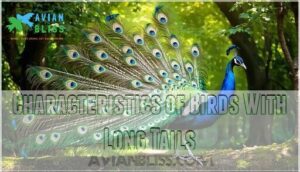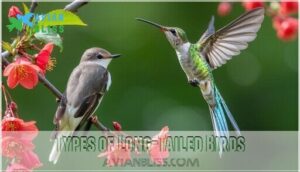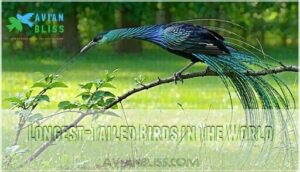This site is supported by our readers. We may earn a commission, at no cost to you, if you purchase through links.

These avian marvels use elongated plumage for intricate communication, impressive courtship displays, and enhanced aerial maneuverability.
Species like the scissor-tailed flycatcher and red-billed streamertail showcase tail lengths that can exceed their body size, serving critical evolutionary functions.
Their spectacular feathers help attract mates, confuse predators, and demonstrate genetic fitness.
From tropical forests to open grasslands, these birds prove that a remarkable tail isn’t just decoration—it’s a powerful adaptation that tells a complex story of natural selection and biological ingenuity.
Want to unravel more **fascinating secrets?
Table Of Contents
- Key Takeaways
- Birds With Long Tails Overview
- Characteristics of Birds With Long Tails
- Types of Long-Tailed Birds
- Longest-Tailed Birds in The World
- Birds With Long Tails for Flight
- Birds With Long Tails for Courtship
- Unique Features of Long-Tailed Birds
- Geographic Distribution of Long-Tailed Birds
- Conservation Status of Long-Tailed Birds
- Facts About Long-Tailed Birds
- Frequently Asked Questions (FAQs)
- Which birds have long tails?
- What birds have large tail feathers?
- What bird has the longest tail feather?
- What is a long tailed bird?
- Which hummingbird has the longest tail feathers?
- Which birds have long tail extensions?
- Which bird has the longest tail feathers?
- What are some examples of long-tailed birds?
- Which bird has a long feather tail?
- What is a brown bird with long tail feathers?
- Conclusion
Key Takeaways
- You’ll discover that long tail feathers aren’t just decorative – they’re sophisticated survival tools that help birds navigate, communicate, and attract mates with incredible precision.
- These elongated plumes serve multiple critical functions, from aerodynamic flight control to complex courtship displays that signal genetic fitness to potential partners.
- You’ll find that tail length varies dramatically across species, with some birds sporting tail feathers that can exceed their body length and transform their aerial capabilities.
- By studying long-tailed birds, you’ll understand how evolution has crafted remarkable adaptations that help these creatures thrive in diverse ecosystems from tropical forests to open grasslands.
Birds With Long Tails Overview
You’ll be amazed by the incredible world of birds with long tail feathers, nature’s most spectacular aerial artists.
These remarkable creatures use their elongated plumage for everything from intricate courtship displays to precise aerial navigation, showcasing the remarkable adaptations that make them true evolutionary marvels. Nature’s most spectacular aerial artists make them true evolutionary marvels.
Nature’s long-tailed birds: aerial artists painting the sky with evolutionary brilliance and survival’s most stunning feathered brushstrokes.
Evolutionary Advantages
Throughout evolutionary history, long tail feathers have been nature’s precision-engineered survival tools for birds.
These remarkable appendages aren’t mere decorations—they’re sophisticated flight instruments that dramatically enhance survival capabilities. By reducing air resistance and providing exceptional maneuverability, long tails help birds navigate complex environments with incredible agility.
Sexual selection plays a role, as tail length often signals genetic fitness to potential mates.
Predator evasion becomes dramatically more effective with these aerodynamic extensions, allowing birds to execute split-second directional changes.
From tropical forests to open grasslands, long tail feathers represent a remarkable adaptation that continues to fascinate ornithologists and nature enthusiasts alike.
Communication and Mating
Concerning birds, tail feathers are nature’s ultimate matchmaking tool. These extravagant plumage signals speak volumes about genetic fitness and attraction potential. During courtship rituals, birds transform into living art, using feather displays to catch a potential mate’s eye.
- Long-tailed Widowbirds showcase half-meter tails like runway models
- Peafowl shimmer with iridescent tail performances
- Males fan and spread feathers to prove their worth
- Tail signals communicate health and genetic quality
- Complex mating dances reveal intricate species recognition
Sexual selection drives these spectacular displays, where females carefully evaluate potential partners through elaborate tail movements and courtship performances. It’s a high-stakes dating game where only the most impressive performers win reproductive rights.
Balance and Flight
Imagine your bird’s tail as a high-performance aircraft control surface!
Long tail feathers transform flight dynamics, providing incredible aerodynamic advantages that reduce air resistance while generating up to 30% additional lift.
These remarkable appendages work like precision instruments, enabling remarkable maneuverability.
- Tail feathers can independently adjust for complex slow-flight movements
- Delta-wing principles explain how tails create stability during aerial navigation
- Sophisticated positioning allows precise steering, braking, and landing techniques
Birds leverage their tail structures through intricate energy expenditure, balancing evolutionary tradeoffs that make flight not just possible, but extraordinarily efficient.
Characteristics of Birds With Long Tails
The intricacy of tail feather structure reveals nature’s most brilliant design.
You’ll discover how longtailed birds use their plumage like living Swiss Army knives, with each feather serving multiple critical functions. Tail length variation isn’t just aesthetic – it’s a survival strategy engineered through millions of years of evolution.
Some species sport tail feathers that lock together with microscopic barbs, creating aerodynamic masterpieces that enable complex flight maneuvers.
Their skeletal adaptations support these remarkable appendages, allowing birds to communicate, balance, and attract mates through stunning displays.
The feather shedding process guarantees peak performance, while plumage coloration signals everything from genetic fitness to territorial boundaries.
Whether iridescent or subtly camouflaged, these tail feathers are more than decoration – they’re sophisticated tools of survival and communication in the avian world. Longtailed birds use their plumage like living Swiss Army knives, with each feather serving multiple critical functions. The feather shedding process guarantees peak performance.
Types of Long-Tailed Birds
You’ll discover a fascinating world of birds sporting extraordinary tail feathers that serve far more than aesthetic purposes.
From the scissor-tailed flycatcher’s dramatic silhouette to the red-billed streamertail’s vibrant plumage, these avian species showcase nature’s remarkable design of elongated tail structures.
These structures play key roles in survival, communication, and mate attraction.
Scissor-Tailed Flycatcher
Scissor-tailed flycatchers reign supreme among longtailed birds, with graceful tails that slice through southern Great Plains skies.
These aerial artists spread their distinctive forked tails wide, transforming utility lines into hunting perches where they snatch insects mid-flight.
Males boast spectacular tail feathers stretching nine inches long, making them nature’s most impressive flycatchers.
Defending their territory with bubbling calls, these birds showcase remarkable tail morphology that helps them navigate and hunt with unparalleled precision.
They thrive in habitats with open areas and scattered trees.
Red-Billed Streamertail
Because Jamaica boasts unique wildlife, the Red-Billed Streamertail stands out as a Jamaican endemic hummingbird with jaw-dropping tail characteristics.
Male birds flaunt extraordinary emerald plumage and ribbon-like tail feathers during spectacular courtship displays.
These nectar thieves zip between mountain flowers with precision, their 9-10 inch wingspan showcasing nature’s aerial mastery while playing a central pollination role in their native ecosystem.
You can even find Red-Billed Streamertail merchandise online.
Taiwan Blue Magpie
If you’re tracking Taiwan’s vibrant forest dwellers, the Blue Magpie will catch your eye with its striking look.
- Sporting blue feathers with long tail plumage
- Inhabiting mountain forests up to 1,200 meters
- Thriving in social, small-group dynamics
With an iridescent blue coat and jet-black head, this native Taiwanese bird flaunts its elegant tail feathers, representing an affirmation to nature’s artistry in Taiwan’s unique ecosystem.
Common/Ring-Necked Pheasant
Strut into the domain of the Common Pheasant, a dazzling bird species where males boast copper plumage and emerald-green heads.
Their spectacular long tail feathers—stretching up to 20 inches—serve important roles in courtship and flight.
Roaming grasslands and farm edges, these Pheasants showcase nature’s remarkable design, balancing beauty with survival through stunning plumage and adaptive strategies.
These feathers are often collected and used to create various decorative crafts. Their spectacular long tail
Long-Tailed Widowbird
If you’ve ever wondered about nature’s most impressive tailors, meet the Long-tailed Widowbird—a master of avian fashion in African grasslands.
Males showcase jaw-dropping tail feathers up to 20 inches long, transforming ordinary flight into a spectacular mating dance.
- Their jet-black plumage screams genetic fitness
- Females judge potential mates by tail length
- Tail feathers become living billboards of health
- Sexual selection drives this breathtaking evolutionary art
These living masterpieces prove that in the bird world, size truly matters.
Longest-Tailed Birds in The World
After exploring vibrant long-tailed birds, we now crown the absolute champions of tail length!
Some birds transform simple feathers into extraordinary displays that’ll blow your mind.
- The Ribbon-tailed Astrapia reigns supreme, with tail streamers over three times its body length—a true measurement marvel in extreme tail morphology.
- Reeves’s Pheasant holds the record with an astounding 2.5-meter tail, pushing evolutionary pressures to spectacular limits.
- Long-tailed Widowbird males sport jet-black plumes that stretch nearly 50 centimeters, proving nature’s incredible feather growth factors.
These avian showstoppers challenge our understanding of bird tail length records!
Birds With Long Tails for Flight
You’ll be fascinated by how some birds use their elongated tail feathers as precision flight instruments that help them navigate complex aerial environments.
These remarkable avian adaptations allow certain species to perform incredible aerial maneuvers with exceptional control and efficiency.
Indian Paradise Flycatcher
A mesmerizing jewel of Asian forests, the Indian paradise flycatcher captivates bird enthusiasts with its extraordinary plumage variation and breathtaking tail feathers.
Male dimorphism creates a stunning visual display:
- Males boast pristine white plumage with trailing tail feathers stretching up to 30 centimeters
- Females showcase rufous-colored tails, expertly blending into forest backgrounds
- These migratory birds navigate diverse landscapes, from dense woodlands to rural gardens
Despite growing conservation challenges, these birds continue to demonstrate remarkable breeding habits and mating success, elegantly hunting insects mid-flight and symbolizing nature’s incredible adaptability.
Long-Tailed Broadbill
Deep within the lush rainforests of Southeast Asia, the Long-Tailed Broadbill reigns as a feathered acrobat, showcasing remarkable tail adaptations that define its survival.
These avian species navigate dense forest canopies with incredible precision, using their long tail feathers as a sophisticated flight control mechanism.
Their robust bill allows them to snatch insects mid-air with surgical accuracy, while traveling in tight-knit social groups of 4-8 individuals.
Broadbill behavior reveals a complex social structure, with diet ranging from small insects to ripe berries.
Their vibrant blue-green plumage and distinctive tail morphology make them standout members of their ecosystem, embodying the intricate balance between form and function in bird tail adaptations.
White-Tailed Tropicbird
Ready to meet the aerial master of tropical oceans? The white-tailed tropicbird soars with unparalleled grace, its stunning long tail feathers slicing through salty winds like nature’s most elegant paintbrush.
These seabirds showcase remarkable adaptations that make flight look effortless:
- Ribbon-like tail feathers for precision steering
- Brilliant white plumage reflecting oceanic sunlight
- Exceptional diving skills for capturing marine prey
- Incredible migration routes spanning vast distances
- Aerodynamic body design optimized for long-distance flight
With global populations spanning tropical marine regions, these birds embody freedom on the wing.
Greater Roadrunner
From the white-tailed tropicbird’s oceanic grace, we zoom into the desert’s speedy maverick: the Greater Roadrunner.
This ground-dwelling bird transforms desert survival into an art form, using its long tail feathers like a precision steering mechanism during high-speed chases.
- Roadrunner Adaptations: Masters of southwestern landscapes
- Desert Survival: Thriving where others wither
- Hunting Strategies: Swift predators battling snakes
- Cultural Significance: Iconic symbols of resilience
Capable of sprinting up to 20 mph, roadrunners leverage their tail morphology for remarkable maneuverability.
Their tail isn’t just for show—it’s a critical tool for balance, navigation, and survival in the harsh desert ecosystem.
They’re known to eat venomous snakes, showcasing their fearless nature.
These birds don’t just live in their environment; they completely own it.
Birds With Long Tails for Courtship
You’ll discover how some male birds transform their extraordinary tail feathers into powerful tools of seduction during mating season.
These avian artists use elongated, vibrant plumage to catch a potential mate’s eye, showcasing nature’s most spectacular courtship performances.
Common Pheasant
If flight-loving birds caught your eye, meet the show-stopping Common Pheasant.
This copper-feathered performer transforms farmlands and woodlands into personal stages during mating season.
| Feature | Description |
|---|---|
| Tail Length | Up to 20 inches |
| Habitat | Farmlands, woodlands |
| Diet | Seeds, insects |
| Courtship | Dramatic wing beats |
| Plumage | Iridescent copper |
Male pheasants fan spectacular tail feathers, dancing boldly to attract mates, proving nature’s most impressive long-tailed performers.
Exclamatory Paradise-Whydah
The Exclamatory Paradise Whydah alters into a striking spectacle during breeding season, sporting tail feathers that dwarf its body.
Males discharge incredible aerial displays, showcasing intricate plumage crafted to win female attention through brood parasitism and mimicry behavior.
- Tail feathers extend three times body length
- Dramatic seasonal transformation occurs
- Complex mating rituals demonstrate evolutionary fitness
These long-tailed paradise whydahs epitomize nature’s remarkable strategy for reproductive success, where stunning physical adaptations become the ultimate courtship performance.
Green Peafowl
Green peafowl: nature’s most dazzling forest dancers in Southeast Asia.
With iridescent green feathers and tail plumes stretching up to 6 feet, males perform spectacular courtship displays.
These rare pheasants face extinction due to habitat loss, challenging their survival across shrinking territories.
Conservation efforts are critical to preserving these magnificent birds’ genetic diversity and stunning mating rituals.
Superb Lyrebird
After the vibrant dance of the Green Peafowl, meet the Superb Lyrebird—nature’s ultimate mimic with unparalleled performance skills.
These Australian forest dwellers boast:
- 16 intricate tail feathers forming spectacular fans
- Extraordinary mimicry abilities
- Complex courtship displays
- Impressive vocal range
- Unique habitat adaptations
Males transform forest floors into living stages, recreating everything from chainsaw sounds to perfect bird calls.
Their tail evolution showcases nature’s remarkable design for attracting mates through sheer auditory and visual spectacle.
Unique Features of Long-Tailed Birds
You’ll be amazed by the fascinating world of long-tailed birds, where tail feathers serve far more than just aesthetic purposes.
These remarkable avian species showcase unique adaptations that help them balance, communicate, and attract mates through their extraordinary tail lengths and configurations. Unique adaptations help them balance, communicate, and attract mates.
Fork-Tailed Flycatcher
The Fork-tailed Flycatcher’s remarkable tail morphology transforms South America’s grasslands into its personal hunting ground.
These aerial artists slice through the air with unparalleled grace, using their extraordinary tail feathers for precision navigation and insect capture.
- Watch it hover like a helicopter, pinpoint-targeting flying prey
- Witness its 7,000-kilometer migration challenge survival limits
- Marvel at its sleek gray and white plumage cutting wind currents
- Observe its bold territorial defense against much larger birds
Surviving through incredible adaptability, this scissor-tailed marvel embodies nature’s most ingenious design strategies.
White-Throated Magpie-Jay
Meet the White-Throated Magpie-Jay, a bold aviator slicing through Central America’s tropical dry forests with its remarkable 25-30 cm tail.
These intelligent birds redefine social behavior, forming cooperative family groups where younger members pitch in to raise chicks—a fascinating twist in bird tail functions.
Their bright blue plumage and distinctive whitethroated magpiejay markings make them stand out against forest canopies.
Incredibly adaptive, they feast on a varied diet of insects, fruits, and eggs, showcasing their versatile nesting habits.
Despite habitat loss threatening their ecosystems, these long-tailed beauties continue to demonstrate remarkable resilience, using their impressive vocalizations and complex social structures to survive and thrive in challenging environments.
Great Argus Pheasant
Imagine a living masterpiece of nature: the Great Argus Pheasant, a bird that turns heads with its jaw-dropping tail display!
Nature’s living art: a bird whose tail becomes a breathtaking stage of survival and seduction.
These Southeast Asian rainforest inhabitants showcase extraordinary courtship artistry through their remarkable plumage.
- Males spread magnificent six-foot wingspan fans
- Intricate eyespots create mesmerizing 3D visual effects
- Tail feathers serve critical mating communication
- Rainforest habitats face increasing conservation challenges
With survival hanging in the balance, these pheasants represent more than just beautiful birds—they’re living symbols of evolutionary adaptation.
Their complex Argus courtship ritual transforms the forest floor into a stunning performance stage, highlighting nature’s incredible design for survival and attraction.
Alexandra’s Parrot
Soaring from the Great Argus Pheasant’s domain, Alexandra’s Parrot emerges as a jewel of the Australian skies.
These vibrant green avian wonders sport tail feathers stretching up to 14 inches—often eclipsing their body length. With iridescent plumage and razor-sharp intelligence, they’re masters of mimicry and social connection.
- Brilliant emerald feathers catch sunlight
- Vocal talents rival linguistic experts
- Flock dynamics reveal complex social structures
- Survival instincts sharpen their adaptability
- Natural beauty defies simple description
Alexandras Parrot thrives in diverse habitats, showcasing remarkable adaptability.
Their conservation needs highlight the delicate balance between wild populations and human interaction, making them not just a bird species, but a living attestation to nature’s intricate design.
Geographic Distribution of Long-Tailed Birds
You’ll find long-tailed birds scattered across diverse global ecosystems, from tropical rainforests to temperate woodlands.
Their remarkable geographical spread showcases nature’s incredible adaptability, with species thriving in regions ranging from South America’s lush landscapes to Africa’s varied terrains.
Tropical Regions
Tropical rainforests burst with extraordinary long-tailed birds that showcase nature’s artistic brilliance.
Nestled in lush Southeast Asian and South American ecosystems, these vibrant avian species like the Greater Bird-of-Paradise and Ribbon-tailed Astrapia flourish in diverse island habitats.
Long-tailed Paradise-Whydahs add dramatic flair to African landscapes, their exotic tail feathers a demonstration to the incredible bird tail diversity found in these rich, colorful tropical environments.
Many species use their tails for attracting mates. Nature’s artistic brilliance.
Temperate Regions
During temperate zones, long-tailed birds like the Long-tailed Duck and Long-tailed Jaeger showcase remarkable seasonal adaptations.
Breeding across northern landscapes from Alaska to Siberia, these birds navigate challenging environments with incredible resilience.
Their survival strategies include specialized nesting habits and migration patterns that protect them through harsh winters.
- Temperate bird habitats demand extraordinary adaptability, with species developing unique mechanisms to conserve energy and maintain population stability.
Songbirds and pheasants transform their bird tail feathers, molting strategically to survive temperature fluctuations.
Their remarkable capacity to thrive in fluctuating climates demonstrates nature’s incredible design, turning seasonal challenges into opportunities for survival and renewal. Nature’s incredible design.
Endangered Species
From the open landscapes of temperate regions, we now spotlight the precarious world of endangered long-tailed birds.
Climate change and human interference are shrinking their chances of survival.
- Habitat loss decimates critical nesting grounds
- Poaching disrupts delicate population dynamics
- Fragmented ecosystems threaten biodiversity
- Conservation funding becomes a lifeline
These majestic birds aren’t just losing ground—they’re losing their entire world.
Bird conservation efforts are more than a choice; they’re a responsibility.
By protecting bird habitats and understanding population trends, we can help these stunning species bounce back from the brink of extinction.
Every action counts.
Conservation Status of Long-Tailed Birds
You’ll want to know why some of the most spectacular long-tailed birds are fighting for survival in today’s rapidly changing ecosystems.
Conservation efforts are critical for protecting these magnificent creatures, whose intricate tail feathers guarantee their survival but also represent nature’s stunning evolutionary artistry.
Threats to Long-Tailed Birds
Long-tailed birds face mounting threats that challenge their survival.
From Southeast Asian forests to global landscapes, these feathered marvels are under siege by human activities. Habitat loss, climate change, and invasive species chip away at their delicate ecosystems.
| Threat | Impact | Regions |
|---|---|---|
| Habitat Destruction | Critical | Tropical Zones |
| Climate Disruption | Severe | Worldwide |
| Hunting Pressure | Moderate | Multiple Regions |
| Pollution | Growing | Global Range |
Bird conservation starts with understanding these challenges.
Conservation Efforts
Conservation of long-tailed birds demands a multi-pronged approach.
Bird conservation organizations are pioneering captive breeding programs and anti-poaching strategies to protect vulnerable species.
Habitat preservation initiatives engage local communities, while public awareness campaigns educate people about these remarkable creatures.
Research teams track populations, creating legislation efforts that safeguard these winged wonders and their fragile ecosystems. Climate change impacts necessitate adaptation strategies.
Climate change impacts necessitate adaptation strategies.
Protected Areas
When conservation efforts wind down, protected areas emerge as critical sanctuaries for birds with long tail feathers. These ecological reserves offer lifelines in a challenging world:
- Tambopata National Reserve shields the Resplendent Quetzal
- Kruger National Park protects Long-tailed Widowbirds
- Royal Chitwan National Park preserves Indian Paradise Flycatchers
- Daintree National Park champions Victoria’s Riflebirds
Consider purchasing national park passes to support these areas.
Your support matters! By championing habitat preservation and community involvement, you’re helping secure these stunning species’ future against poaching and environmental threats.
Facts About Long-Tailed Birds
You’re about to explore the fascinating world of birds with long, eye-catching tail feathers that serve far more than just a decorative purpose.
These remarkable avian species have evolved unique tail characteristics that play key roles in flight, communication, and mate attraction across diverse ecosystems.
Diet and Habitat
Foraging with finesse, long-tailed birds master habitat diversity like nature’s precision hunters.
From tropical forest canopies to grassy savannas, these feathered specialists select prey with remarkable adaptability.
Their dietary strategies reveal intricate niche partitioning—some snatch insects mid-flight, while others pluck seeds or sip sweet nectar, proving birds with long tail feathers are survival artists.
Behavior and Social Structure
One might marvel at the intricate social worlds of long-tailed birds, where fascinating behaviors unfold beyond mere flight.
- Birds establish complex social hierarchies through strategic territorial defense
- Pair bonds develop through elaborate courtship rituals
- Cooperative breeding strategies guarantee species survival
- Tail movements communicate nuanced social signals
These feathered societies operate with remarkable precision. Dominant individuals claim prime territories, while group dynamics dictate access to resources.
During mating seasons, males transform into living performance art, executing spectacular tail displays that signal genetic fitness.
Warning calls ripple through flocks, protecting members from potential threats. Their social structures reveal a symphony of communication, where every flutter and movement speaks volumes about survival, reproduction, and interconnectedness.
Interesting Long-Tailed Bird Species
As social behavior shapes their world, these long-tailed birds captivate with extraordinary feather engineering. Check out nature’s most stunning aerial architects:
- Ribbon-tailed Astrapia: Its white tail streamers stretch an incredible three feet, dwarfing its tiny body
- Superb Lyrebirds: Masters of mimicry, blending sixteen specialized tail feathers with complex song performances
- Greater Racket-tailed Drongos: Aerial acrobats creating whistling symphonies through paddle-shaped tail displays
These exotic birds showcase tail feather evolution as both communication tool and survival strategy.
Frequently Asked Questions (FAQs)
Which birds have long tails?
You’ll be amazed at the jaw-dropping length of tails on birds like the Ribbon-tailed Astrapia, Resplendent Quetzal, and Scissor-tailed Flycatcher!
These feathered stunners sport incredible tail lengths that’ll make you stop and stare in wonder. Complete concepts
What birds have large tail feathers?
You’ll find large tail feathers on the Ribbon-tailed Astrapia, Marvelous Spatuletail, Resplendent Quetzal, and Indian Peafowl.
These stunning birds showcase nature’s incredible design, using their magnificent tails for courtship and survival. Complete concepts
What bird has the longest tail feather?
You’ll be amazed that the Ribbon-tailed Astrapia’s male boasts tail feathers reaching up to three feet long – nearly four times its body length.
This makes it the undisputed champion of extreme tail length in the bird world.
What is a long tailed bird?
You’ll spot a long-tailed bird by its tail feathers stretching well beyond its body, like the stunning Ribbon-tailed Astrapia or the exotic Resplendent Quetzal.
These birds use their lengthy tails for balance, communication, and attracting mates.
Which hummingbird has the longest tail feathers?
Like a vibrant ribbon dancing in the wind, the Red-billed Streamertail hummingbird boasts the longest tail feathers.
You’ll be captivated by its extraordinary tail, which can stretch up to three times the length of its body.
Which birds have long tail extensions?
You’ll encounter remarkable long-tailed birds like the Ribbon-tailed Astrapia, Resplendent Quetzal, and Red-billed Streamertail.
These birds showcase extraordinary tail extensions that can be dramatically longer than their body, serving purposes of attraction and communication.
Which bird has the longest tail feathers?
Hold onto your binoculars!
You’ll be stunned by the Ribbon-tailed Astrapia, a magnificent bird boasting tail feathers that can stretch an incredible three times longer than its entire body, making it the record-holder for the longest tail feathers.
What are some examples of long-tailed birds?
You’ll love discovering long-tailed birds like the ribbon-tailed astrapia, resplendent quetzal, and scissor-tailed flycatcher.
These stunning creatures boast impressive tail feathers that can stretch several times their body length, creating a mesmerizing aerial display.
Complete concepts are presented in logically grouped separate lines.
Which bird has a long feather tail?
You’ll find the Ribbon-tailed Astrapia boasts incredibly long tail feathers that can stretch up to three times its body length.
This stunning bird’s tail is a remarkable example of nature’s extraordinary design in avian species.
What is a brown bird with long tail feathers?
Imagine a world where brown wings whisper stories of wilderness.
You’ll spot the pheasant, a master of camouflage, sporting elegant long tail feathers that dance with each graceful stride through forest and field.
Conclusion
Soaring beyond mere aesthetics, birds with long tail feathers embody nature’s remarkable design strategy.
You’ve discovered how these avian marvels leverage their extraordinary plumage for survival, communication, and reproductive success.
Understanding these remarkable creatures reveals the intricate dance of evolution—where form meets function in stunning biological complexity.
Their elongated tails aren’t just beautiful; they’re precise tools of adaptation that demonstrate the incredible ingenuity of the natural world. Nature’s remarkable design strategy.
- https://web.stanford.edu/group/stanfordbirds/text/uessays/uSexual_Selection.html
- https://scholarsarchive.byu.edu/cgi/viewcontent.cgi?article=2590&context=gbn
- https://en.wikipedia.org/wiki/Pin-tailed_whydah
- https://royalsocietypublishing.org/doi/10.1098/rspb.2009.0090
- https://www.berkeley.edu/news/media/releases/2009/03/11_streamer.shtml












